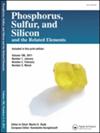Understanding the reactivity of phosphorus pentasulfide with a series of phosphoryl chloride derivatives: Interplay between σ-hole, π-hole and H-bonding interactions
IF 1.4
4区 化学
Q4 CHEMISTRY, INORGANIC & NUCLEAR
Phosphorus, Sulfur, and Silicon and the Related Elements
Pub Date : 2025-05-04
DOI:10.1080/10426507.2025.2496517
引用次数: 0
Abstract
The reactivity of phosphorus pentasulfide (P2S5) in the presence of a series of phosphoryl chloride derivatives has been investigated using the M06-2X and B3LYP functionals in conjunction with the 6-311 + G(d,p) basis set. Our computations indicate that both the regioselectivity of P2S5 and the physical nature of the interaction in P2S5 complexes can be rationalized using conceptual DFT reactivity indices, natural bond orbitals (NBO) and symmetry-adapted perturbation theory (SAPT2 + dMP2). The molecular electrostatic potential (MEP) of P2S5 exhibits σ- and π-hole regions around the P = S bond: one hole is carried by the S atom and located along the P-S bond, while two others are found at both sides of the P atom. Unlike the P4S10 dimer whose reaction is obstructed by a huge activation energy, its monomeric form (P2S5) successfully yields a product following a reaction path with a low activation energy and involving metastable complex intermediates. The adducts formed along the P = S unit are less stable than those attacking the P = S bond perpendicularly. The process involves the concomitant weakening of the P···S bond of P2S5 and reinforcement of the P=O bond, turning P2S5 into P2S4O.
了解五硫化磷与一系列氯磷衍生物的反应性:σ-空穴、π-空穴和氢键的相互作用
利用M06-2X和B3LYP官能团,结合6-311 + G(d,p)基集,研究了五硫化磷(P2S5)在一系列磷酰氯衍生物存在下的反应性。我们的计算表明,P2S5的区域选择性和P2S5配合物中相互作用的物理性质都可以用概念DFT反应性指数、自然键轨道(NBO)和对称适应微扰理论(SAPT2 + dMP2)来合理化。P2S5的分子静电势(MEP)表现为P = S键周围的σ空穴区和π空穴区,其中一个空穴由S原子携带并位于P-S键上,另外两个空穴位于P原子的两侧。不像P4S10二聚体的反应被巨大的活化能阻碍,它的单体形式(P2S5)成功地产生了一个低活化能的反应路径,涉及亚稳定的复杂中间体。沿着P = S单元形成的加合物比垂直攻击P = S键的加合物更不稳定。这个过程伴随着P2S5的P···S键的减弱和P=O键的增强,使P2S5变成p2s40o。
本文章由计算机程序翻译,如有差异,请以英文原文为准。
求助全文
约1分钟内获得全文
求助全文
来源期刊
CiteScore
2.60
自引率
7.70%
发文量
103
审稿时长
2.1 months
期刊介绍:
Phosphorus, Sulfur, and Silicon and the Related Elements is a monthly publication intended to disseminate current trends and novel methods to those working in the broad and interdisciplinary field of heteroatom chemistry.

 求助内容:
求助内容: 应助结果提醒方式:
应助结果提醒方式:


